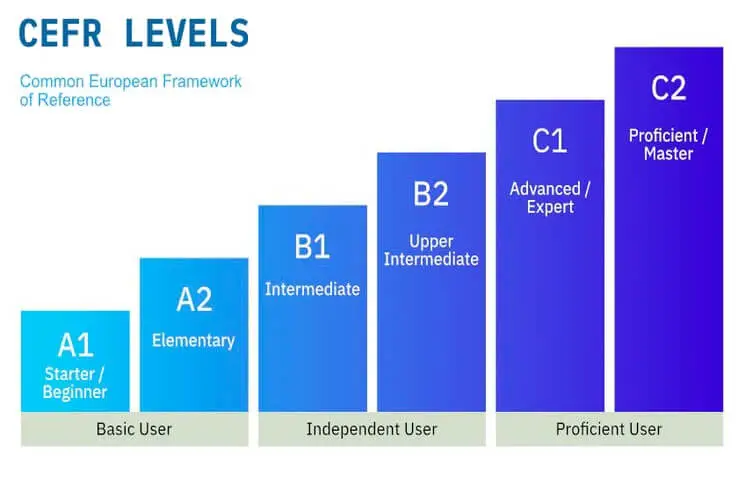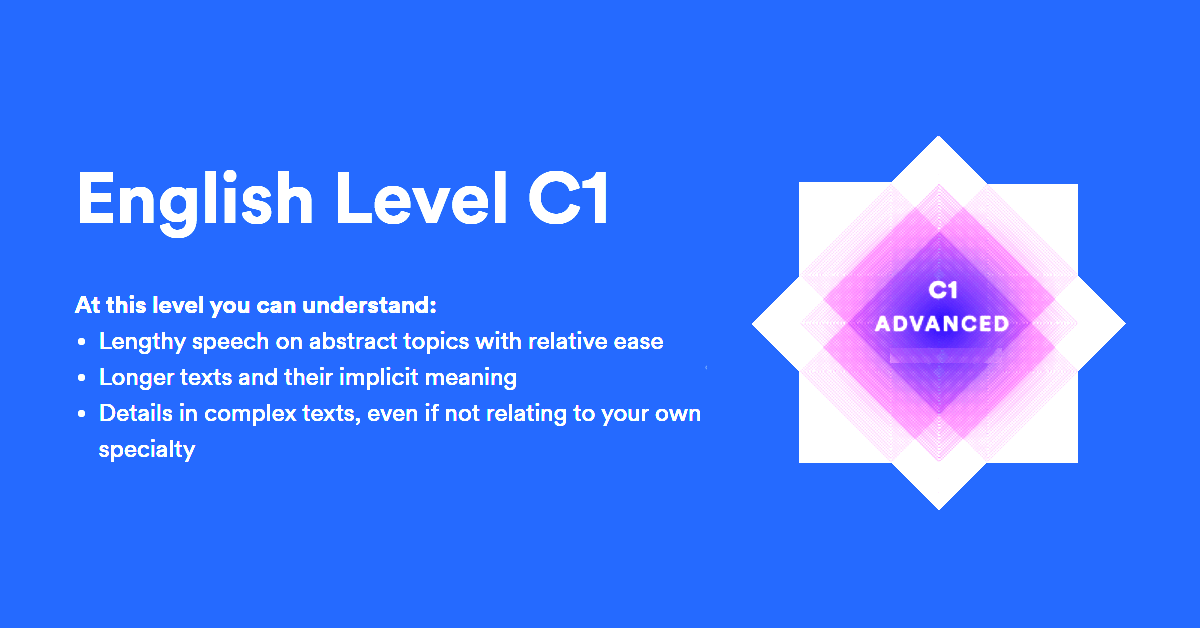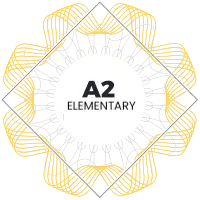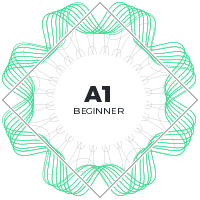C1 English Level (Advanced)
- Key points of detailed texts
- Clear spoken language, whether live or broadcast
- Texts with extensive vocabulary and a high level of independence

C1 Advanced
The Common European Framework of Reference (CEFR), a list of various language proficiency levels created by the Council of Europe, lists English at level C1, which is the fifth level of English. This level is officially referred to as “advanced,” which is also what it might be described in common usage. Students are able to work independently, accurately, and in practically any context at this level, without any prior preparation, on a wide range of subjects.


What are the C1 Level Skills?
Can understand a wide variety of long and demanding texts and recognize implicit meanings in them
Can express themselves fluently and spontaneously without much 01 02 obvious effort to find the right expression
Can make flexible and effective use of the language for social, academic and professional purposes
Can produce clear, well-structured and detailed texts on topics of a certain complexity, showing a correct use of the mechanisms of text organization, articulation and cohesion
What will students be able to do after completing the C1 Advanced English?
Comprehension
Listening Comprehension
- Understand long speeches even when they are not clearly structured and when relationships are only implicit and not explicitly stated.
- Understand TV shows and movies without much effort
Reading Comprehension
- Understand long and complex texts of a literary or factual nature, appreciating distinctions of style
- Understand specialized articles and long technical instructions, even if they are not related to their specialty
Speaking
Oral Interaction
- Express themselves with fluency and spontaneity without having to search for the right expressions in a very obvious way
- Use language flexibly and effectively for social and professional purposes
- Formulate ideas and opinions with precision and relate interventions skillfully to those of other speakers
Oral Expression
- Present clear and detailed descriptions on complex topics that include other subjects, developing concrete ideas and ending with an appropriate conclusion
Writing
Written Expression
- The ability to express themselves in clear and well-structured texts, presenting points of view with a certain length
- Write about complex topics in letters, essays, or reports, highlighting what they consider to be important issues.
- Choose the appropriate style for the target readership
Achieving CEFR Level C1
At the C1 level, students are expected to demonstrate a high degree of fluency and sophistication in their language use. They can express ideas clearly and precisely, even in more complex situations, and are capable of developing well-structured arguments and providing nuanced explanations.
In discussions, students can effectively argue their points, offering detailed explanations, supporting their opinions with relevant evidence, and thoughtfully addressing counterarguments. They can engage in in-depth analysis of topical issues, considering various perspectives and articulating the pros and cons of different approaches. Their ability to contribute actively to informal and formal discussions is advanced, allowing them to evaluate alternatives, propose hypotheses, and respond confidently to others’ ideas.
C1 students are capable of handling social discourse with ease, comprehending detailed spoken language in various environments, including those with background noise. They can initiate and manage conversations effectively, taking turns and concluding discussions naturally. Interaction with native speakers is smooth and spontaneous, with no significant strain on either party.
At this level, students possess a heightened awareness of language use, allowing them to identify and correct mistakes that may lead to misunderstandings. They can monitor their speech for recurring errors and self-correct as needed, contributing to a more polished and accurate use of the language.
C1 Listening
Students at the C1 level can understand extended speech, including complex lines of argument on both familiar and unfamiliar topics. They can follow detailed lectures, presentations, and discussions, grasping the subtleties of meaning. They are also capable of understanding films, news broadcasts, and other spoken content, even when delivered at a fast pace or in a variety of accents.
C1 Reading
At this level, students can read and comprehend a wide range of demanding, longer texts, recognizing implicit meanings and attitudes. They can critically analyze articles, reports, and contemporary literary works, adapting their reading style and speed according to the purpose. They can also efficiently navigate through reference materials and use them selectively to deepen their understanding of complex topics.
C1 Speaking
Students can communicate fluently and spontaneously, engaging in detailed discussions on a wide range of subjects. They can express ideas and opinions clearly, supporting them with detailed arguments and examples. In discussions, they can present well-structured, persuasive arguments and respond effectively to others’ points of view. Their ability to present complex information in a clear and organized manner allows them to discuss specialized topics within their field of interest with ease.
C1 Writing
Students at the C1 level can produce clear, well-structured text on complex subjects, demonstrating a sophisticated use of organizational patterns, connectors, and cohesive devices. They can write essays, reports, and reviews, providing in-depth analysis and commentary. They are also capable of writing in a variety of styles, tailoring their language to suit different purposes and audiences, and can convey nuanced ideas with precision and clarity.
C1 Grammar
C1 grammar refers to the advanced level of English grammar that corresponds to the Common European Framework of Reference for Languages (CEFR) Level C1. At this level, learners have a strong command of English and can use the language effectively and flexibly in a wide range of contexts, including more complex and sophisticated situations. Here are the advanced grammar topics covered at the C1 level:
- Present Perfect Continuous Tense (advanced usage)
- Past Perfect Tense (narrative and complex sentences)
- Past Perfect Continuous Tense (extended and nuanced actions)
- Future Continuous Tense (predictions and plans)
- Future Perfect Tense (time-related actions)
- Future Perfect Continuous Tense (duration by a future point)
- First, Second, and Third Conditional Sentences (complex and hypothetical scenarios)
- Mixed Conditionals (advanced and nuanced conditions)
- Passive Voice (across all tenses, including complex forms)
- Reported Speech (handling complex structures and time shifts)
- Relative Clauses (including advanced use of non-defining clauses)
- Gerunds and Infinitives (with nuanced and idiomatic uses)
- Modal Verbs (expressing advanced concepts like deduction, speculation, and subtle obligations)
- Inversion for Emphasis (structures like “Not only…but also” and “Seldom…”)
- Cleft Sentences (emphasizing specific parts of a sentence)
- Comparative and Superlative Structures (advanced comparisons and subtle distinctions)
- Subjunctive Mood (formal and hypothetical statements)
- Emphatic Structures (emphasizing with “do/does/did”)
- Ellipsis and Substitution (for concise expression and avoiding repetition)
- Linking Words and Phrases (advanced cohesive devices for logical flow)
- Adverbial Clauses (including complex time, reason, contrast, and purpose)
- Participle Clauses (for sophisticated sentence construction)
- Nominal Clauses (used in a variety of sentence roles)
- Conditional Clauses (advanced mixed conditionals and nuanced scenarios)
- Phrasal Verbs (including idiomatic and context-specific uses)
C1 Vocabulary
C1 vocabulary includes an even broader and more sophisticated range of words, phrases, idioms, and expressions that allow learners to engage in complex discussions, present nuanced arguments, and articulate ideas with precision. Examples of C1 vocabulary include:
Work and Business:
- Terms: entrepreneurship, downsizing, outsourcing, profitability, stakeholder, corporate governance
- Phrases: “to streamline operations,” “to leverage resources,” “to mitigate risks,” “to boost productivity”
Education and Learning:
- Terms: pedagogy, dissertation, tenure, accreditation, interdisciplinary, cognitive development
- Phrases: “to defend a thesis,” “to pursue a doctorate,” “to receive tenure,” “to engage in critical thinking”
Travel and Leisure:
- Terms: expedition, itinerary, visa regulations, cultural immersion, ecotourism, wanderlust
- Phrases: “to embark on a journey,” “to immerse oneself in culture,” “to obtain a visa,” “to explore off the beaten path”
Health and Fitness:
- Terms: immunization, holistic medicine, metabolic rate, cardiovascular health, mindfulness, endorphins
- Phrases: “to practice mindfulness,” “to enhance cardiovascular health,” “to undergo immunization,” “to boost endorphin levels”
Technology and Innovation:
- Terms: artificial intelligence, blockchain, automation, big data, cybersecurity, quantum computing
- Phrases: “to harness the power of AI,” “to implement blockchain technology,” “to protect data integrity,” “to stay ahead of technological trends”
Environment and Nature:
- Terms: carbon footprint, deforestation, sustainable development, ecological footprint, green energy, environmental stewardship
- Phrases: “to reduce one’s carbon footprint,” “to combat deforestation,” “to advocate for sustainable development,” “to promote environmental stewardship”
Social Issues:
- Terms: marginalization, gentrification, socioeconomic disparity, social justice, human trafficking, public policy
- Phrases: “to address socioeconomic disparity,” “to advocate for social justice,” “to combat human trafficking,” “to influence public policy”
Adjectives:
- Complex, descriptive adjectives: meticulous, multifaceted, groundbreaking, resilient, transformative, pervasive
Verbs:
- Advanced verbs: synthesize, exacerbate, mitigate, scrutinize, conceptualize, advocate
Adverbs:
- Frequency and degree adverbs: invariably, profoundly, markedly, disproportionately, intrinsically, ostensibly
Phrasal Verbs:
- More complex phrasal verbs: bring about, carry out, phase in, phase out, take up, wind down
Idiomatic Expressions:
- Examples: “push the envelope,” “go the extra mile,” “read between the lines,” “bend over backward,” “let the cat out of the bag”
Collocations:
- Common collocations: “take precedence,” “make a concerted effort,” “have a profound impact,” “gain momentum,” “hold a grudge”
What can someone with an English C1 level do?
Full functionality at work or in school is possible with English at the C1 level. The C1 level would permit complete independence in a nation where English is the primary language.
A person with English language proficiency at the C1 level would:
- able to comprehend a variety of difficult, lengthy texts and discern underlying meaning.
- possess the ability to speak clearly and without having to fumble about for words.
- possess the ability to effectively and flexibly employ language in social, academic, and professional contexts.
- can write writing that is understandable, well-structured, and thorough about complicated topics while demonstrating the careful use of organizational patterns, linkages, and cohesive devices.
Details of C1 level English proficiency
For instructional purposes, the official can-do statements are divided into smaller sections. You can evaluate your own English proficiency using this more thorough skill breakdown, or a teacher can use it to evaluate a student’s proficiency.
For instance, a student in English at level C1 will be able to perform everything that a student at level B2 can do in addition to:
- address in depth success-related topics, such as creating a successful team.
- Describe in detail your favorite paintings and your favorite architectural styles.
- Discuss societal issues, potential fixes, and the role that corporations can play.
- take part in conversations on habitat protection, sustainability, and conservation.
- Discuss current events and concerns and how they effect people and businesses.
- Discuss life’s dangers, such as leaving a job and participating in dangerous sports.
- examine and contrast the various educational modalities and specific institutions.
- talk about numerous comedy styles, including subdued ones like sarcasm.
- recognize several communication modalities, such as direct, indirect, formal, and informal.
- Discuss topics affecting your quality of life, such as work-life balance and the atmosphere in your house.
- comprehend and debate moral dilemmas, such as civil disobedience.





